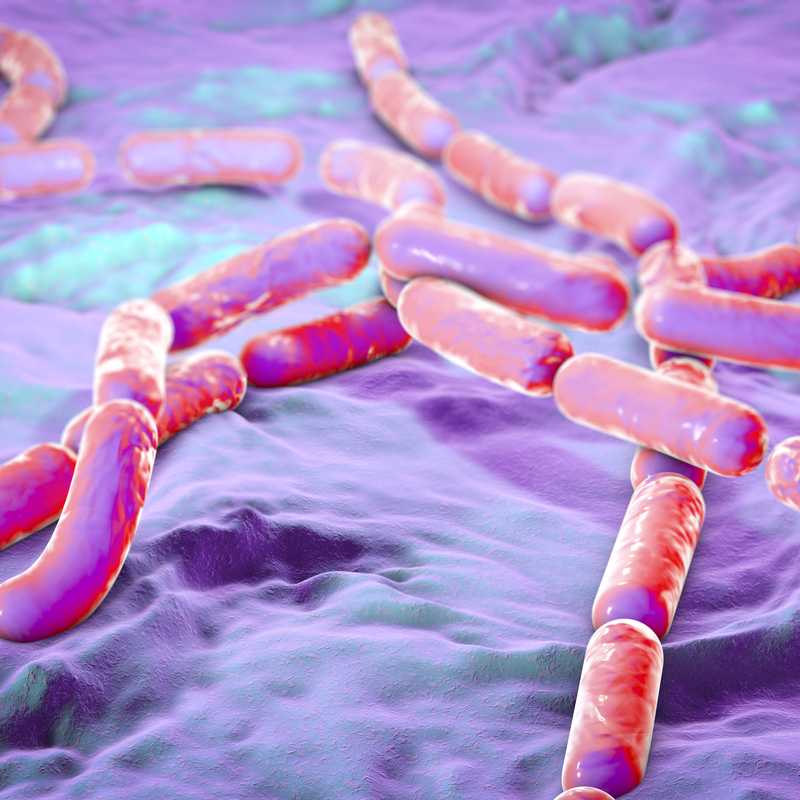
What is the Bacillus cereus pathogen?
Bacillus cereus is a motile, rod-shaped, gram- and catalase-positive, spore-forming and facultatively anaerobic bacterium belonging to the genus Bacillus. The bacterium occurs naturally in the soil with a concentration of up to one million per earth gram. The Bacillus cereus pathogen is thus one of the most common cultivable soil bacteria.
What are the histological characteristics of the Bacillus cereus pathogen?
The majority of Bacillus cereus pathogens thrive in the temperature range from 10 °C to 50 °C. The bacterium is also acid-sensitive and the spores cannot be killed by heat or pasteurisation. 80 percent of all fatty acid chains of the Bacillus cereus pathogen are branched.
Which other bacteria belong to the Bacillus cereus group?
The following bacteria belong to the Bacillus cereus group, are genetically closely related to each other and share a core genome of almost 3,100 genes:
- Bacillus anthracis,
- Bacillus cytotoxicus,
- Bacillus thuringiensis: used as a biopesticide against insects.
The pathogens of the Bacillus cereus group are distinguished by the diseases they cause.
What diseases can the Bacillus cereus pathogen cause?
The Bacillus cereus pathogen produces two different types of toxins that can trigger the following diseases:
- a heat- and acid-stable type, which causes nausea or vomiting after about 0.5 to 6 hours after ingestion of the toxin (known as emetic toxin). More rarely , abdominal cramps and diarrhoea may also occur.
- a heat- and acid-labile species, which can cause a form of watery diarrhoea after about 8 to 16 hours after ingestion of the toxin (so-called diarrhoea toxin). The symptoms usually subside after 12 to 24 hours.
How is the Bacillus cereus pathogen transmitted?
The Bacillus cereus pathogen is transmitted through contaminated food . This mainly affects food that has been stored at room temperature for a long period of time after cooking and is therefore not cooled quickly and effectively.
This circumstance can be explained by the fact that the Bacillus cereus pathogen can survive during heat treatment of the food due to its spore stage. As soon as the conditions for its persistence are more favourable again, it transforms again into a vegetative form. This means that the bacterium is then able to produce toxins.
Which foods are particularly often contaminated by the Bacillus cereus pathogen?
Foods that are particularly often contaminated by the Bacillus cereus pathogen include the following:
- Rice-based foods,
- starchy foods such as pasta or potatoes,
- Mixed products such as soups, sauces, pies, puddings, and meat and dairy products,
- Bakery products,
- various vegetables and salads,
- Tofu
The
most important source of disease for humans are starch-containing foods and rice-based foods. The
spores of the pathogen are mainly found in raw rice and also survive cooking
. If the rice is kept warm below 65°C or reheated
, the bacterium multiplies. If, on the other hand, the rice is kept warm above the
said temperature, the spread of the
pathogen can be prevented. Incidentally,
travel cookers with their keep-warm function work according to this principle.
If foods such as milk, meat, fish and vegetables are improperly prepared, they often trigger the diarrhoea form associated with the Bacillus cereus pathogen.
Foodborne outbreaks of Bacillus cereus pathogens are usually associated with concentrations above 105 CFU/g in . However, cases have also been reported in which vomiting and diarrhoea were triggered by lower concentrations .
How can a Bacillus cereus infection be prevented?
The European Food Safety Authority (EFSA) recommends following certain control practices to prevent infection with Bacillus cereus pathogens. These include, above all, refrigerating food at a maximum temperature of 7 degrees Celsius. Also food should be consumed immediately after preparation if possible . Always use well-cleaned pans and dishes to prepare food. In addition, the work surface on which the food is prepared should be well cleaned to prevent cross-contamination.
What are the symptoms of Bacillus cereus infection?
The symptoms of a Bacillus cereus infection start approximately within 6 hours after ingestion of the contaminated food, can last up to one day and are manifested as follows:
- Nausea,
- Vomiting,
- Abdominal colic
How is the Bacillus cereus pathogen diagnosed?
The methods used so far only allow the determination of the so-called presumptive Bacillus cereus pathogen. The Bacillus cereus group can be determined using the so-called MALDI-TOF method. This method is a mass analysis of chemical compounds and combines matrix-assisted laser desorption ionisation (MALDI) with time-of-flight analysis (TOF).
The diagnosis of a Bacillus cereus infection is based on the clinical symptoms of the patient. For a confirmed diagnosis, B. cereus is infected in food, in vomit and/or faeces by quantitative cultures .
How is a Bacillus cereus infection treated?
A Bacillus cereus infection does not usually require treatment with antibiotics. It is sufficient for the patient to ensure adequate hydration to compensate for fluid loss due to vomiting and/or diarrhoea. In extremely rare cases no Bacillus cereus infection can cause blood poisoning and be fatal.
